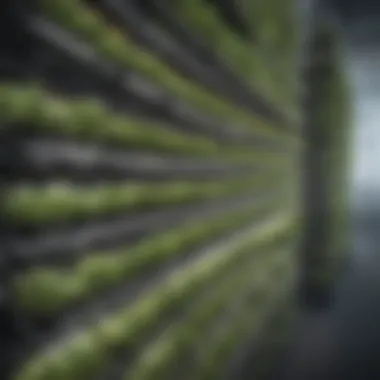Revolutionizing Agriculture: Unveiling the Benefits of Vertical Farming


Understanding the Foundations of Vertical Farming
Vertical farming is a cutting-edge agricultural technique that involves cultivating crops in vertically stacked layers, maximizing space efficiency and resource utilization. This innovative approach leverages advanced technology to enhance crop yield, reduce environmental impact, and enable year-round production. By harnessing automation and optimizing resource allocation, vertical farming presents a compelling solution to address global food security challenges.
Introduction to Vertical Farming
Vertical farming represents a paradigm shift in agriculture, offering a sustainable alternative to traditional farming methods. Through the vertical stacking of plant beds in controlled indoor environments, farmers can cultivate a diverse range of crops in a compact space. This method minimizes land usage, water consumption, and pesticide application, fostering a more eco-friendly and efficient approach to food production.
Key Benefits of Vertical Farming
The advantages of vertical farming extend beyond increased crop yield and space optimization. By growing crops indoors, farmers can mitigate the impact of adverse weather conditions and seasonal fluctuations. This climate-controlled environment enables precise management of factors such as light, temperature, and humidity, promoting consistent crop growth and quality. Additionally, vertical farming reduces reliance on chemical inputs and transportation costs, leading to fresher, more nutritious produce for consumers.
Optimization of Resource Utilization
Vertical farming pioneers the efficient use of resources such as water and energy. Through innovative irrigation systems and LED lighting technology, growers can minimize water wastage and energy consumption while maximizing plant growth. This resource-efficient approach not only reduces operational costs but also contributes to sustainability efforts by lowering agricultural carbon footprints.
Automation in Vertical Farming
Automation plays a pivotal role in the success of vertical farming operations. Utilizing robotics and sensor technology, farmers can monitor and adjust environmental conditions in real-time, ensuring optimal growth conditions for crops. Automated systems also streamline planting, harvesting, and maintenance processes, increasing productivity and reducing labor intensity. By embracing automation, vertical farms achieve greater precision and consistency in crop cultivation, setting new standards for agricultural innovation.
The Future of Agriculture: Vertical Farming
Introduction to Vertical Farming
Vertical farming is a revolutionary approach in agriculture that has the potential to transform the traditional methods of crop cultivation. By embracing the concept of growing crops in vertically stacked layers, this innovative method maximizes space efficiency and resource utilization, offering a sustainable solution to the increasing demand for food production. Through the integration of cutting-edge technology and advanced farming techniques, vertical farming presents a promising alternative to conventional agriculture practices, providing numerous advantages that address key challenges faced by the industry.
Definition and Concept
The evolution of traditional agriculture


The evolution of traditional agriculture signifies a significant shift from traditional horizontal farming practices to vertical cultivation systems. This transition reflects a fundamental change in the way crops are grown and nurtured, emphasizing the importance of space optimization and resource efficiency. The evolution of traditional agriculture has paved the way for innovative farming methods like vertical farming, which offer a more sustainable and productive approach to crop production. While traditional agriculture has its roots in centuries-old practices, the evolution towards vertical farming embodies a modern and forward-thinking approach that is tailored to meet the demands of a rapidly changing agricultural landscape.
Vertical farming principles and techniques
Vertical farming principles and techniques encompass a diverse set of strategies aimed at maximizing crop yield in a vertically stacked environment. From hydroponics and aeroponics to controlled environment agriculture, vertical farming leverages technology and science to create ideal growth conditions for plants. The integration of artificial lighting, climate control systems, and automated irrigation methods distinguishes vertical farming as a high-tech agricultural practice that prioritizes precision and efficiency. While these techniques offer advantages such as increased productivity and decreased water usage, they also present challenges related to initial setup costs and maintenance requirements.
History of Vertical Farming
Pioneers in vertical farming
The inception of vertical farming can be attributed to visionary individuals and organizations that championed this innovative approach to agriculture. Pioneers in vertical farming, through their dedication and experimentation, laid the foundation for the development of vertical farming as a viable alternative to traditional farming methods. Their early contributions helped shape the principles and best practices observed in modern vertical farming operations, contributing to the evolution of this industry. However, like any pioneering effort, the road to success was fraught with challenges and setbacks that required perseverance and innovation to overcome.
Milestones in vertical farming development
The evolution of vertical farming has been marked by key milestones that signify significant advancements and breakthroughs in the field. These milestones, ranging from technological innovations to large-scale implementations, have propelled vertical farming into the realm of mainstream agriculture. Each milestone represents a stepping stone towards achieving greater efficiency, sustainability, and productivity in vertical farming practices. While these achievements have garnered attention and acclaim for the industry, they also serve as reminders of the ongoing journey towards further innovation and growth in vertical farming.
Benefits of Vertical Farming
Vertical farming is a transformative agricultural method that offers a multitude of advantages. This section delves deep into the importance of embracing vertical farming in the context of sustainable agriculture. Through innovative techniques, vertical farming presents unique benefits that enhance crop yield, environmental sustainability, and year-round production.
Increased Crop Yield
In the realm of increased crop yield, optimized growth conditions play a pivotal role. Optimized growth conditions focus on creating an environment that maximizes plant growth potential. Key characteristics include precise temperature control, adequate water supply, and optimal nutrient distribution. These conditions foster accelerated plant development and higher crop yields. The unique feature of optimized growth conditions lies in its ability to mimic ideal growth settings, ensuring plants thrive efficiently. While resource-intensive, the advantages of optimized growth conditions in augmenting crop yield make it a prominent choice for modern agricultural practices.
Year-round production advantages
Year-round production advantages center on the continual cultivation of crops regardless of seasonal variations. By implementing techniques such as controlled environment agriculture, vertical farms can offer a sustainable solution for year-round production. The key characteristic of year-round production advantages is the elimination of seasonal constraints, ensuring a consistent food supply. A unique feature lies in the ability to control light, temperature, and humidity to simulate ideal growing conditions. While energy-intensive, the benefits of year-round production advantages, such as reduced reliance on external factors for crop growth, make it an advantageous choice for sustainable agriculture.
Environmental Sustainability


The facet of environmental sustainability in vertical farming is crucial for ecological harmony. By focusing on reduced water usage, vertical farming mitigates unnecessary water wastage in agricultural practices. Reduced water usage emphasizes efficient water management through innovative irrigation systems and water recapture methods. The key characteristic is the strategic utilization of water resources, minimizing waste and maximizing efficiency. A unique feature includes hydroponic and aeroponic systems that optimize water delivery to plants. Despite initial setup costs, the advantages of reduced water usage in preserving freshwater resources make it a sustainable choice for agricultural operations.
Minimal Pesticide Requirements
In alignment with environmental sustainability, vertical farming advocates for minimal pesticide requirements to reduce chemical contamination in food production. By implementing integrated pest management strategies and natural pest control measures, vertical farms minimize pesticide usage. The key characteristic is the emphasis on biological pest control methods that maintain a balance in the ecosystem. A unique feature includes the use of beneficial insects as natural predators to manage pest populations organically. While labor-intensive, the advantages of minimal pesticide requirements in promoting safe and toxin-free food align with the ethos of sustainable agriculture.
Resource Efficiency
Resource efficiency in vertical farming optimizes land and energy consumption for sustainable agricultural practices. By maximizing land usage, vertical farms efficiently utilize limited space by implementing vertical growing systems. The key characteristic involves multi-tiered cultivation structures that make full use of vertical space. A unique feature includes the utilization of recycled materials for construction, promoting eco-friendly farming practices. Despite initial investment costs, the advantages of maximizing land usage in conserving arable land and promoting urban agriculture make it a viable choice for resource-conscious farming.
Energy-saving Practices
Energy-saving practices in vertical farming aim to reduce carbon footprint and operational costs associated with agricultural activities. By incorporating energy-efficient lighting systems and renewable energy sources, vertical farms minimize energy consumption. The key characteristic lies in the implementation of LED lighting that promotes photosynthesis efficiency while lowering electricity usage. A unique feature includes the integration of solar panels to harness renewable energy for farm operations. Despite upfront expenditures, the advantages of energy-saving practices in reducing operational expenses and environmental impact align with the principles of sustainable agriculture.
Technological Innovations in Vertical Farming
Technological innovations play a pivotal role in the realm of vertical farming. They are the driving force behind the advancement and efficiency of this modern agricultural approach. One of the key elements that make technological innovations in vertical farming so crucial is their ability to revolutionize traditional farming methods. By embracing cutting-edge technologies, vertical farming can optimize crop production while minimizing resource consumption. These advancements act as catalysts for enhancing sustainability and productivity in agricultural practices.
Automation and Robotics
Role of automation in vertical farming
Automation is a fundamental component of vertical farming systems. It involves the integration of automated processes to streamline various tasks such as planting, watering, and harvesting. The role of automation in vertical farming is to alleviate the manual labor traditionally associated with agriculture. This results in increased efficiency, precision, and consistency in crop cultivation. Automation also enables farmers to monitor and manage their crops more effectively, ultimately leading to higher yields and quality produce.
Advantages of robotic systems
Robotic systems are a core aspect of the automation revolution in vertical farming. Their primary advantage lies in their ability to perform repetitive and labor-intensive tasks with unparalleled accuracy and speed. Robotic systems contribute significantly to the overall goal of enhancing agricultural productivity. They can operate 247, ensuring continuous monitoring and care of crops. Additionally, robotic systems minimize the risk of human error, leading to improved crop health and increased output. Despite their initial investment costs, the long-term benefits of robotic systems in vertical farming are substantial, making them a wise choice for modern agricultural practices.
LED Lighting Systems


LED lighting systems are integral to the success of vertical farming operations. They provide artificial light sources that simulate natural sunlight, promoting photosynthesis and ensuring optimal plant growth. The benefits of LED lighting in crop growth are manifold. LED lights are energy-efficient, consuming significantly less power compared to traditional lighting systems. This results in cost savings and environmental benefits, aligning with the sustainability goals of vertical farming. Moreover, LED lighting systems offer customizable light spectra, allowing farmers to tailor lighting conditions based on specific crop requirements.
Benefits of LED lighting in crop growth
LED lighting in crop growth contributes to higher yields and improved crop quality. By providing the ideal light spectrum for different plant stages, LED lights promote accelerated growth and development. This precision in lighting control leads to faster harvest cycles and consistent, high-quality produce. Additionally, LED lighting reduces heat emissions, creating a more comfortable working environment for farmers and minimizing energy wastage.
Energy-efficient lighting solutions
Energy-efficient lighting solutions are a cornerstone of sustainable agricultural practices. In the context of vertical farming, utilizing energy-efficient lighting is paramount to reducing operational costs and environmental impact. These lighting solutions not only lower electricity expenses but also decrease carbon footprints associated with agricultural activities. By adopting energy-efficient lighting solutions, vertical farms can operate efficiently while minimizing their ecological footprint, thereby contributing to a greener and more sustainable food production landscape.
Challenges and Future Prospects
Vertical farming presents a promising solution to global food security challenges. Within this context, understanding the challenges and future prospects of vertical farming is crucial. One key aspect that demands attention is the sustainability challenges inherent in this innovative agricultural approach. These challenges revolve around energy consumption concerns and waste management issues, both of which play a significant role in determining the long-term viability of vertical farming. By addressing these challenges effectively, the potential benefits of vertical farming can be fully realized.
Sustainability Challenges
Energy consumption concerns
Energy consumption concerns stand out as a critical focal point when considering sustainability in vertical farming. The high energy demands of vertical farming systems can impact overall operational costs and environmental sustainability. Implementing energy-efficient practices and exploring renewable energy sources are essential strategies in mitigating these concerns. By optimizing energy usage through innovative solutions, vertical farming can enhance its eco-friendly profile and long-term economic viability.
Waste management issues
Effective waste management is another paramount aspect of sustainability in vertical farming. The production of agricultural waste within vertical farming systems must be carefully managed to minimize environmental impact. Implementing recycling initiatives, exploring composting methods, and investing in sustainable waste disposal practices are essential for addressing waste management issues. By adopting comprehensive waste management strategies, vertical farming can further solidify its position as a sustainable agricultural method with reduced ecological footprint.
Expansion and Adoption
The expansion and adoption of vertical farming have the potential to revolutionize the agricultural landscape on a global scale. Understanding the global growth potential of vertical farming is pivotal in recognizing its widespread impact. The scalability and adaptability of vertical farming make it a favorable choice for meeting the increasing demand for food production in a rapidly growing population. By harnessing the unique features of vertical farming, such as efficient space utilization and controlled growing conditions, the global growth potential of this agricultural method can address food security challenges on a large scale.
Global growth potential of vertical farming
The global growth potential of vertical farming lies in its capacity to revolutionize traditional agricultural practices. By maximizing crop yield in limited spaces and reducing reliance on external factors like weather conditions, vertical farming offers a sustainable solution for meeting the food demands of a growing population. Additionally, the implementation of advanced technology and data-driven approaches in vertical farming further enhances its scalability and potential for global expansion.
Integration into urban landscapes
Integrating vertical farming into urban landscapes presents a unique opportunity to enhance food production within metropolitan areas. The key characteristic of this integration is the utilization of underutilized urban spaces for vertical farming installations. By repurposing abandoned buildings, rooftops, or vertical structures, urban landscapes can be transformed into vibrant hubs of agricultural productivity. The advantages of this integration include reduced food miles, increased access to fresh produce, and the promotion of sustainable urban development through green infrastructure initiatives.
By exploring the challenges, opportunities, and future prospects of vertical farming, it becomes evident that this innovative agricultural method holds immense potential in reshaping the way we approach food production in a sustainable and efficient manner.



